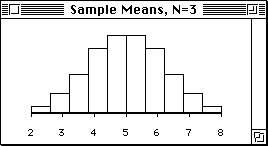Statistics, Science, and Observations
-
Statistics,
Science, and Observations
- Overview
The two most fundamental concepts underlying inferential
statistics are introduced in this lecture. These are:
- Sampling Distributions which are distributions
of sample statistics (such as the mean), not of observations.
- The Central Limit Theorem which allows us to
- find the probability of getting any specific sample.
We discuss this in this lecture.
- make inferences from samples about populations.
We begin discussion of this next week, and continue
for the remainder of the semester.
- Three types of Distributions
-
Sample Distribution
- A sample distribution is an observed distribution
of the values that a variable is observed to have
for a sample of individuals. We have seen numerous sample
distributions.
-
Population Distribution
- A population distribution is a theoretical distribution
of the values that a variable can take on in a
population of individuals. We have also learned about
population distributions (normal and binomial).
-
Sampling Distribution
- A sampling distribution is a theoretical distribution
of the values that a specified statistic of a sample
takes on in all of the possible samples of a specific
size that can be made from a given population. We
have not discussed sampling distributions before.
Note that we can have sampling distributions of sample
means, of sample standard deviations, etc.
- Demonstration of Sampling
Distributions
- Example:
-
SAT Math Sample Distribution
- Consider the SAT-Math variable that we observed in the
survey done on the first day of class. This example is
from 1997. You can
download the 1999 data and compare results.
Sample Statistics, Population Parameters
and Sample Frequency Distribution for SAT Math |
| Statistics & Parameters |
Sample Frequency Distribution |
Sample Statistics
Samp. Mean = 589.39
Samp. Stand. Dev. = 94.35 |

Legend: Red = males; Blue = females.
|
Population
Parameters
Pop. Mean = 460
Pop. Stand. Dev. = 100 |
SAT MATH SAMPLE DISTRIBUTION
Samp. Mean = 589.39
Samp. Stand. Dev. = 94.35
-
SAT Math Population Distribution
- The population distribution for SAT Math scores is a
normal distribution with mean of 460 and standard deviation
of 100.

SAT Math Population Distribution: Normal, Mean=460,
StDv=100
-
SAT Math Distribution of Sample Means (n=41)
- The Distribution of sample means, for samples of size
n=41, when the population has a mean of 460 and a standard
deviation of 100, is:

SAT Math Sampling Distribution of means
Samples size n=41 (Std.Err.=15.6)
(We'll know what the Std.Err. is by the end of the
lecture!)
- So What? We can determine how likely it is that
the class is a sample that came from the general population
of those taking the SAT Math examination.
Your sample mean is 589.39. We will conclude
it is very very very very unlikely (probability
is within 16 decimal places of 0) to get a sample like
this from the general population of those taking the
SAT Math exam.
Conclusion: This class is not a sample from
the general population of those taking the SAT Math
exam! Your average score is much much much much better!
(But, we knew that all along :-)
How do we do this? We need to understand Sampling
Distributions and the Central Limit Theorem!
Here we go ...
-
- Sampling Distribution of Sample Means
-
Definition: Sampling Distribution
- A sampling distribution is a theoretical distribution
of the values that a specified statistic of a sample
takes on in all of the possible samples of a specific
size that can be made from a given population.
-
Definition: Distribution of Sample Means (the full
name is Sampling Distribution of Sample Means)
- A sampling distribution of sample means is a theoretical
distribution of the values that the mean of a sample
takes on in all of the possible samples of a specific
size that can be made from a given population.
-
Example from Graveter and Wallnau
-
- The point of this example is:
- Even though the population is not normal, the
sampling distribution will approximate a normal
distribution.
- The approximation becomes better as the sample
size gets larger.
-
- Graveter and Wallnau consider a population that only
has 4 scores:
[2, 4, 6, 8].
This population is very non-normal (it's called
"uniform"). It's distribution looks like this:

Population Distribution
for [2, 4, 6, 8]
This Population is very non-normal (uniform)
- Graveter and Wallnau use this population as the basis
for constructing a distribution of sample means for
sample size of 2 (that is: N=2). They explain how this
distribution is constructed. The distribution is shown
below:

Sampling Distribution of Sample Means (N=2)
This distribution is only roughly normal.
- We extend their example by constructing distributions
of sample means for sample sizes of N=3, N=4 and N=5,
following the same approach taken by Graveter and Wallnau.
All four sampling distributions of the sample means
are shown below. You can download
the ViSta Applet that creates these distributions.

Sampling Distribution of Sample Means (N=3)
Normality is better than those above.

Sampling Distribution of Sample Means (N=4)
Normality is even better than those above.

Sampling Distribution of Sample Means (N=5)
This distribution is very normal.

Sampling Distribution of Sample Means (N=6)
This distribution is even more normal.
-
- To repeat the point of this example:
- Even though the population is not normal, the
sampling distribution will approximate a normal
distribution.
- The approximation becomes better as the sample
size gets larger.
- The Central Limit Theorem
In the example just given above, we were able to exactly determine
the distribution of sample means. We could do this because
the population was so simple, having only four scores.
Usually, we can't do this.
When we can't exactly determine the distribution of sample
means, we can use the central limit theorem to understand
its general characteristics. This is also true for the distribution
of other sample statistics.
For this reason, the central limit theorem serves as a
cornerstone of much of inferential statistics.
-
Definition:
- The Central Limit Theorem (C.L.T.): For any population
with mean and standard deviation
 and and  , ,
the distribution of sample means for sample size n
will, as n approaches infinity, approach a normal
distribution with mean and standard deviation
 and and  . .
-
-
The Central Limit Theorem is the most important point
of the semester!
WHY? Because of the following two points:
- The C.L.T. describes the distribution of sample
means (or of any other sample statistics) of
any population, no matter what shape, mean
or standard deviation it has.
- The distribution of sample means approaches normality
very rapidly. By the time the sample reaches n-30,
the distribution is almost perfectly normal. Just
look at our example!
-
The C.L.T. describes the distribution of sample means
(and any other sampling distribution) according to three
characteristics:
- The SHAPE tends to be normal. It will be
almost perfectly normal if
- The population from which the samples are drawn
are normal
- The sample size (n) in each sample is relatively
large, around 30 or more.
- The MEAN of the distribution of sample means.
- The expected value is the name given
to the mean of the distribution of sample means
(or of any other sample statistic).
- The expected value is equal to the population
mean (or other sample statistic).
- The STANDARD DEVIATION of the distribution
of sample means.
- The standard error is the name given
to the standard deviation of the distribution
of sample means (or of any other sample statistic).
- The smaller the population standard deviation,
the smaller the standard error.
- The standard error is equal to the standard
deviation of the population divided by the square
root of the sample size.

- The larger the sample size, the smaller the
standard error.
- ViSta C.L.T. Applet
-
- ViSta Applet on Central Limit
Theorem. This can be done in ViSta directly by simply
using the FILE MENU's SIMULATE DATA menu item.
- Probability and the Sampling Distribution
We now know how to calculate the distribution of sample means
for SAT Math scores (i.e., the SAT Math sampling distribution
of means).
We know that
- SHAPE: The distribution is normal.
- MEAN: The mean
 = 460. = 460.
- STANDARD ERROR: The standard error
 (standard deviation of the sampling distribution) of sample
means is calculated using the following formula
(standard deviation of the sampling distribution) of sample
means is calculated using the following formula

Thus, we can draw the distribution. Here it is:

SAT Math Sampling Distribution of means
Samples size n=41 (Std.Err.=15.6)
We can use the distribution of sample means to answer
the following question:
Given that the scores on the SAT Math exam
follow a normal distribution with a mean of 460 and
a standard deviation of 100, what is the probability
of obtaining this class's sample of scores (mean=589.93,
N=41)? (We now know that the sampling distribution of
sample means is normal with a mean of 460 and a standard
error of 15.6).
We answer this question by calculating the Z-score for
the mean of the scores on the SAT Math exam reported by
members of this class (the sample).
This means that the Z-score for your SAT Math sample
mean of 589.39 is:

This Z-score is so large it is not in any Z tables.
If we use ViSta to calculate the probability of getting
such a Z-score it tells us it is 0.00 (which actually
means it is less than .0000000000000001).
Thus, our answer to the question above is that the
probability is (essentially) zero that the members of
this class represent a sample drawn at random from the
general population of those taking the SAT math examination.
Conclusion: As we said at the outset, this class
is not a sample from the general population of those
taking the SAT Math exam! Your average score is much
much much much better!
|